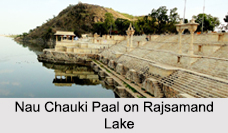 Kankroli is a small town located in the district of Rajsamand in Rajasthan. It is well known for Dwarikadhish temple. This, too, is amongst the many places that are part of the excursion tours from Udaipur. This town is located 65 kilometers away from Udaipur.
Kankroli is a small town located in the district of Rajsamand in Rajasthan. It is well known for Dwarikadhish temple. This, too, is amongst the many places that are part of the excursion tours from Udaipur. This town is located 65 kilometers away from Udaipur.
Tourist Spots of Kankroli
Kankroli is mainly popular for possessing various religious places; among them the most famous is Dwarikadhish Temple. Apart from that, this place is also surrounded by some other popular tourist spots, which are Rajsamand Lake and Nau Chauki Paal-
Dwarikadhish Temple: The Dwarkadhish temple is the major attraction of this town. The idol of Lord Dwarikadhish was brought to this temple in 1671 A.D during the rule of Maharana Raj Singh. Earlier, king Ambrish worshiped Prabhu Dwarikadhish at Arbuda hills (Mount Abu) from where the deity was shifted by various devotees finally to Mahaprabhu Vallabhacharya. The third grandson of Vallabhacharya, Shri Bal Krishna Lal took the possession of the deity and since then, Kankroli is known as the third peeth of vaishnav religion or "Shuddhadwait" or "Pushtimarg". A library is also part of this Temple complex. This library has a remarkable collection of old books. People from across the country gather in large numbers at Dwarikadhish Temple to seek the blessings of Lord Dwarikadhish.
Rajsamand Lake: Rajsamand Lake was built in the 17th century by Maharana Raj Singh. It is approximately 1.75 miles wide, 4 miles long and 60 feet deep. It was built across the Gomati, Kelwa, and Tali rivers, with a catchment area of approximately 196 sq meters. Rajsamand Lake is one of the five popular lakes of Mewar. It is also known by Rajsamudra Lake in Rajasthan.
The river Gomti is the main supplier of water to Rajsamand Lake. This was created by building an impressive dam in the 17th century. Rajsamand Lake was made the seaplane base of Imperial Airways during World War II, for over six years. Recently, the water has got damaged by the mining of the marble in the catchment area for the last three decades.
 Nau Chauki Paal: On the embankment of the Rajsamand lake, there are nine pavilions or `Nau Chauki` (nine ghats), which were built by Maharana Raj Singh. These beautifully carved pavilions are festooned with pictures of the sun, chariots, gods, birds and detailed carvings. The history of Mewar is inscribed in 1017 stanzas, on 27 marble slabs, which are called the Raj Prasasti. It has been acclaimed as one of the longest etchings in India.
Nau Chauki Paal: On the embankment of the Rajsamand lake, there are nine pavilions or `Nau Chauki` (nine ghats), which were built by Maharana Raj Singh. These beautifully carved pavilions are festooned with pictures of the sun, chariots, gods, birds and detailed carvings. The history of Mewar is inscribed in 1017 stanzas, on 27 marble slabs, which are called the Raj Prasasti. It has been acclaimed as one of the longest etchings in India.
Apart from the above mentioned places Gupteshwar Mahadev Temple, Irrigation Garden, Dayal Shah Killa (Dayal Shah Fort), Vithhal Vilas Baug, R.K. Garden (100 Ft), Tulsi Sadhna Shikhar, Ann Purna Mandir, Awari Mata Mandir are some of the other places of Kankroli which are also worth visiting.
Visiting Information to Kankroli
Kankroli is well connected to all other major cities by train and bus routes. Kankroli Railway Station is the nearest to this place. There are no direct flights available to Kankroli; however Dabok Airport would be convenient to reach Kankroli.



















